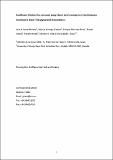Por favor, use este identificador para citar o enlazar a este item:
http://hdl.handle.net/10261/114941COMPARTIR / EXPORTAR:
 SHARE SHARE
 CORE
BASE CORE
BASE
|
|
| Visualizar otros formatos: MARC | Dublin Core | RDF | ORE | MODS | METS | DIDL | DATACITE | |

| Título: | Sunflower (Helianthus annuus) long-chain acyl-coenzyme A synthetases expressed at high levels in developing seeds |
Autor: | Aznar-Moreno, José A. CSIC ORCID ; Venegas-Calerón, Mónica CSIC ORCID ; Martínez-Force, Enrique CSIC ORCID ; Garcés Mancheño, Rafael CSIC ORCID ; Mullen, Robert; Gidda, Satinder K.; Salas, Joaquín J. CSIC ORCID | Palabras clave: | Acyl‐CoA synthetase Oil biosynthesis Helianthus annuus Sub‐cellular location Substrate specificity |
Fecha de publicación: | 2014 | Editor: | Blackwell Publishing | Citación: | Physiologia Plantarum 150: 363- 373 (2014) | Resumen: | Long chain fatty acid synthetases (LACSs) activate the fatty acid chains produced by plastidial de novo biosynthesis to generate acyl-CoA derivatives, important intermediates in lipid metabolism. Oilseeds, like sunflower, accumulate high levels of triacylglycerols (TAGs) in their seeds to nourish the embryo during germination. This requires that sunflower seed endosperm supports very active glycerolipid synthesis during development. Sunflower seed plastids produce large amounts of fatty acids, which must be activated through the action of LACSs, in order to be incorporated into TAGs. We cloned two different LACS genes from developing sunflower endosperm, HaLACS1 and HaLACS2, which displayed sequence homology with Arabidopsis LACS9 and LACS8 genes, respectively. These genes were expressed at high levels in developing seeds and exhibited distinct subcellular distributions. We generated constructs in which these proteins were fused to green fluorescent protein and performed transient expression experiments in tobacco cells. The HaLACS1 protein associated with the external envelope of tobacco chloroplasts, whereas HaLACS2 was strongly bound to the endoplasmic reticulum. Finally, both proteins were overexpressed in Escherichia coli and recovered as active enzymes in the bacterial membranes. Both enzymes displayed similar substrate specificities, with a very high preference for oleic acid and weaker activity toward stearic acid. On the basis of our findings, we discuss the role of these enzymes in sunflower oil synthesis. © 2013 Scandinavian Plant Physiology Society. | URI: | http://hdl.handle.net/10261/114941 | DOI: | 10.1111/ppl.12107 | Identificadores: | doi: 10.1111/ppl.12107 issn: 0031-9317 |
| Aparece en las colecciones: | (IG) Artículos |
Ficheros en este ítem:
| Fichero | Descripción | Tamaño | Formato | |
|---|---|---|---|---|
| Postprint_Physiologia_Plantarum_2014_363.pdf | 795,73 kB | Adobe PDF |  Visualizar/Abrir |
CORE Recommender
SCOPUSTM
Citations
34
checked on 10-abr-2024
WEB OF SCIENCETM
Citations
30
checked on 25-feb-2024
Page view(s)
369
checked on 15-abr-2024
Download(s)
520
checked on 15-abr-2024
Google ScholarTM
Check
Altmetric
Altmetric
NOTA: Los ítems de Digital.CSIC están protegidos por copyright, con todos los derechos reservados, a menos que se indique lo contrario.
